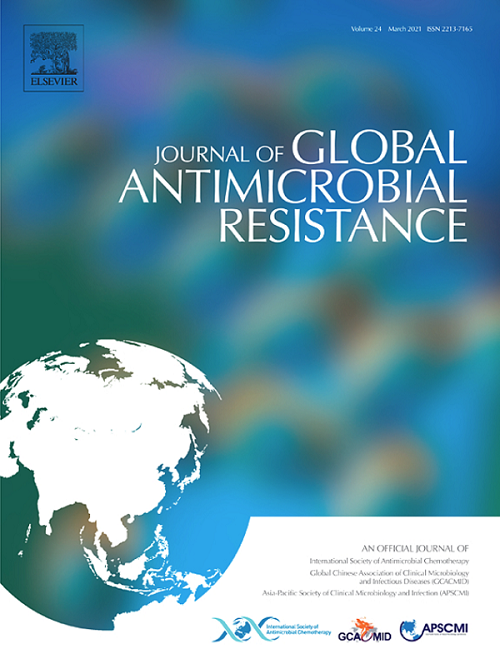临床耐碳青霉烯的布拉氏柠檬酸杆菌分离株中共存的blaNDM-1、blaKPC-2和mcr-9.1的全基因组测序
IF 3.2
3区 医学
Q2 INFECTIOUS DISEASES
引用次数: 0
摘要
目的:利用全基因组测序技术研究携带blaNDM-1、blaKPC-2和mcr-9.1的耐碳青霉烯型braakii柠檬酸杆菌的分子特征和临床特征。方法:采用自动微生物学系统检测布拉基c菌(WF0082)对22种抗菌药物的敏感性。使用Illumina和Nanopore平台进行全基因组测序。测定抗性基因和质粒复制子类型。比较菌株间基因结构,分析碳青霉烯(blaNDM-1和blaKPC-2)质粒性质和基因环境,以及动员型粘菌素耐药基因(mcr-9.1)。利用核心单核苷酸多态性构建进化树。结果:WF0082对除粘菌素外的所有抗生素均耐药。blaNDM-1位于IncX3质粒的截断转座子Tn125上。blaKPC-2位于IncP6/IncX6质粒中,IncP6/IncX6质粒是一种新型的共轭质粒,其核心blaKPC平台(iskpn27 - blaem -1-blaKPC-2-ΔISKpn6-korC-klcA-orf279-orf396-ΔrepB)主要来源于转座子Tn6296。mcr-9.1核心区由rcnR-rcnA-pcoE-ΔpcoS-IS903B-mcr-9.1-wbuC-IS26组成,与Tn6725残基相似。系统发育分析表明,该菌株属于C1支系,与澳大利亚和中国分离的布拉基c具有高度同源性。结论:本研究结果表明,携带blaNDM-1、blaKPC-2和mcr-9.1三个质粒的布拉克氏杆菌WF0082菌株对抗菌药物具有高度耐药性。C. braakii容易整合外源基因的能力有可能严重破坏临床治疗,迫切需要加强对含有多种耐药基因的菌株的监测。本文章由计算机程序翻译,如有差异,请以英文原文为准。
Whole-genome sequencing of coexisting blaNDM-1, blaKPC-2, and mcr-9.1 in a clinical carbapenem-resistant Citrobacter braakii isolate
Objective
We aimed to characterize the molecular characteristics and clinical features of carbapenem-resistant Citrobacter braakii carrying blaNDM-1, blaKPC-2, and mcr-9.1 using whole-genome sequencing.
Methods
The susceptibility of C. braakii (WF0082) to 22 antimicrobial drugs was tested by an automated microbiology system. Whole-genome sequencing was performed using the Illumina and Nanopore platforms. Resistance genes and plasmid replicon types were determined. Gene structure was compared between strains to analyse the plasmid properties and gene environments of carbapenem (blaNDM-1 and blaKPC-2) and mobilized colistin resistance genes (mcr-9.1). The core single-nucleotide polymorphisms were used to construct an evolutionary tree.
Results
WF0082 was resistant to all antibiotics excluding colistin. blaNDM-1 was located on the truncated transposon Tn125 in the IncX3 plasmid. blaKPC-2 was located in the IncP6/IncX6 plasmid, a novel conjugative plasmid whose core blaKPC platform (ISKpn27-blaTEM-1-blaKPC-2-ΔISKpn6-korC-klcA-orf279-orf396-ΔrepB) was derived mainly from the transposon Tn6296. The mcr-9.1 core region consisted of rcnR-rcnA-pcoE-ΔpcoS-IS903B-mcr-9.1-wbuC-IS26, and it was similar to the Tn6725 remnant. Based on phylogenetic analysis, the present strain was categorized into the C1 clade, and it was highly homologous to C. braakii isolates from Australia and China.
Conclusions
The results of this study showed that C. braakii strain WF0082 carrying blaNDM-1, blaKPC-2, and mcr-9.1 located on three plasmids was highly resistant to antimicrobial drugs. The ability of C. braakii to easily integrate foreign genes has the potential to seriously undermine clinical therapy, and it is urgent that the surveillance of strains harbouring multiple resistant genes is strengthened.
求助全文
通过发布文献求助,成功后即可免费获取论文全文。
去求助
来源期刊

Journal of global antimicrobial resistance
INFECTIOUS DISEASES-PHARMACOLOGY & PHARMACY
CiteScore
8.70
自引率
2.20%
发文量
285
审稿时长
34 weeks
期刊介绍:
The Journal of Global Antimicrobial Resistance (JGAR) is a quarterly online journal run by an international Editorial Board that focuses on the global spread of antibiotic-resistant microbes.
JGAR is a dedicated journal for all professionals working in research, health care, the environment and animal infection control, aiming to track the resistance threat worldwide and provides a single voice devoted to antimicrobial resistance (AMR).
Featuring peer-reviewed and up to date research articles, reviews, short notes and hot topics JGAR covers the key topics related to antibacterial, antiviral, antifungal and antiparasitic resistance.
 求助内容:
求助内容: 应助结果提醒方式:
应助结果提醒方式:


